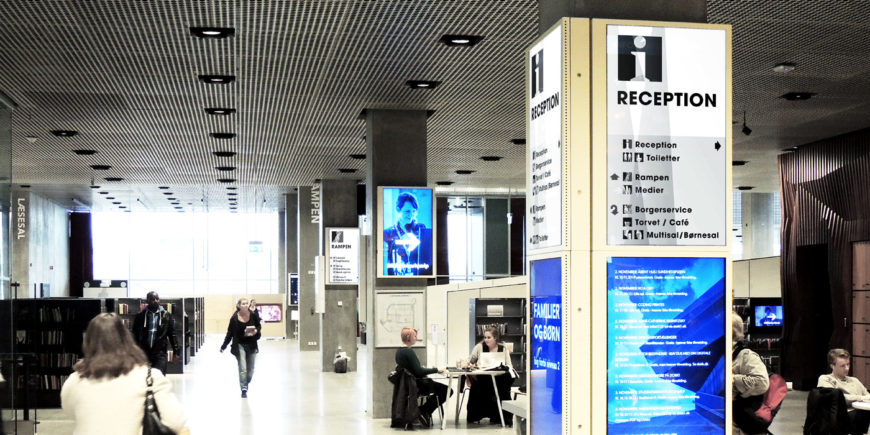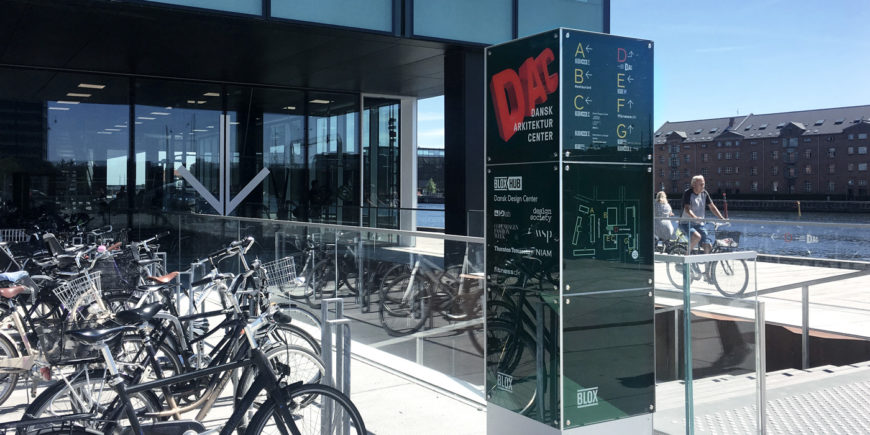Triagonal designs bespoke wayfinding and information solutions for public spaces – indoors and outdoors.
We have dedicated ourselves to develop wayfinding systems and concepts that enable people to find the way on their own, and we truly believe that good wayfinding empowers people and make them feel safe, confident and independent.
Wayfinding in public spaces
Want to know more?

With our public space wayfinding solutions:
- We provide solutions designed to contribute to the specific cultural context of a place, tell stories and communicate brands.
- We improve the flows and desired behaviour of people, facilitate commercial traffic or access to culture and experiences.
- We contribute to improved operational performance.
Indoor wayfinding and navigation
At Triagonal we deliver indoor wayfinding solutions for several types of public institution as well as commercial spaces like:
- Wayfinding in museums
- Wayfinding in community spaces
- Mall wayfinding
- Corporate wayfinding
- Office wayfinding
While these spaces all have different purposes and characteristics the architectural context always plays a significant part when we create a wayfinding concept for a public space. Triagonal aims at delivering solutions that complement the architectural expression while at the same time communicating the intentional use of a space and enhancing people’s understanding of the location.

Efficient wayfinding can serve as the key to unlocking a space and to understanding how to move within it. A strong information system and a tailored graphic expression help users navigate and strengthen the environment’s spatial identity and brand recognisability.
Interior wayfinding
A core element in our wayfinding strategies is traditional wayfinding signage. But we also include other interior elements that can help lead the way. By including characteristic architectural and spatial elements in the wayfinding strategy, we support the natural affordances of the space and create optimal user flows. Triagonal’s CEO, Tina Ravbjerg explains:
“This can be done e.g. by using art or super graphics on walls or floors, by colour coding departments or by using light and furniture creatively to create natural paths and routes. These elements can nudge our behaviour and strengthen our ability to find our bearings, because they work as landmarks along the route, and thereby support our memory. When these elements are respectfully integrated in the architecture, wayfinding becomes a natural part of the overall experience of the spaces.”
By mixing interior wayfinding signage with other creative interior elements Triagonal creates dynamic spaces that guide people intuitively through to their goal.

At Triagonal we also explore the potential for digitalising wayfinding information. Whether it is adding e.g. dynamic signage to support flexibility or creating a platform where users can get personalised wayfinding information, we explore the value digitalisation can add together with the client and find solutions that match the specific project.
Go to Services to learn more about the services we can include in your project.
Creative wayfinding signage
In Triagonal’s solutions the visual expression of information systems consists of a range of elements, which when combined in a balanced way help to clarify the communication of your narrative.
Colour is such an important ingredient when designing creative directional signage, and for many different reasons. Besides adding a distinct visual coding to the systems, colour also supports the differentiation of destinations and types of information alongside e.g. font sizes and pictograms.
Colour is a core element when communicating a strong brand story, but it also plays an important role in reinforcing the functionality of a wayfinding system. Using a combination of colours, letters and numbers makes a wayfinding system accessible and legible to more people with different abilities.

At Triagonal we often draw inspiration from the cultural settings we are designing for to add local flavour. In collaboration with our clients, colours and combinations are prototyped and tested for appearance, contrasts and readability. The result is a customized palette of colours that supports the overall wayfinding strategy and the brand of the client.
Do you want to know more about our approach to wayfinding graphics and our creative approach? Get in contact with Peter Donner.
Outdoor Wayfinding
Triagonal delivers outdoor wayfinding solutions for public as well as private clients.
Examples include:
- Campus wayfinding
- Car park wayfinding
- Stadium wayfinding
But also, urban wayfinding like:
- Pedestrian wayfinding and maps
- City wayfinding
- Park wayfinding
Functional wayfinding signage systems
Providing the right information in the right place is key to making people feel confident, when navigating in unfamiliar surroundings. The different outdoor spaces we design for are characterised by different types of flow processes.
In public spaces like a zoo or museum there is often one central entrance at a clearly defined space, where people move freely and quite randomly through. While in city centres and other urban spaces, there are no central entry points and people move freely around between different destinations.

These differences in flow typologies determine what the user flows look like at the different places and therefore also what type of information is needed at different locations. These need to be reflected in the wayfinding systematics and information strategies to create a functional wayfinding signage system.
As people move freely and randomly in public spaces, wayfinding for public spaces encompasses much more than just getting from A to B as fast as possible. It’s also about providing people with a first-class experience that is characteristic for the particular place they are visiting.
Outdoor wayfinding signage
The main difference from interior wayfinding signage is that the scale – and in many cases the visibility of the outdoor wayfinding signs – is vastly different, allowing for larger landmark style signs when appropriate. Signage on buildings to enhance entrances etc. are also potential solutions.

An important factor to consider when designing outdoor wayfinding signage is differentiating between information for vehicles and for pedestrians. Inside a car you are almost functionally blind when it comes to information, – every message needs to be simple and crystal clear in order to work. As for pedestrians you can normally deliver the information using designs similar to interior signage, because they can stop and decipher the information.
Furthermore, the weather needs to be considered. In our industrial design we take weather conditions seriously, such as snow, rain, wind, sun, excessive heat etc. resulting in designs that match the local context and are durable and easy to maintain.
Do you want to know more about what we can do for you and your organisation? Get in contact here.



